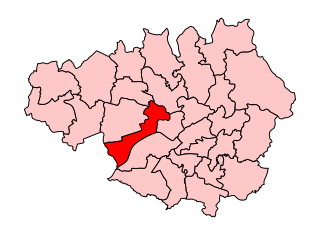
North Norfolk is a constituency represented in the House of Commons of the UK Parliament since 2024 by Steffan Aquarone, a Liberal Democrat.

Monmouth was a county constituency of the House of Commons of the Parliament of the United Kingdom. The seat was created for the 1918 general election. From 2005 until 2024 the Member of Parliament (MP) was David Davies of the Conservative Party.

Aberdeen North is a burgh constituency of the House of Commons of the Parliament of the United Kingdom and it elects one Member of Parliament (MP) by the first past the post system of election. It was first used in the 1885 general election, but has undergone various boundary changes since that date. The seat has been held by Kirsty Blackman of the Scottish National Party since 2015.

Ashford is a constituency in Kent created in 1885 and represented in the House of Commons of the UK Parliament since 2024 by Sojan Joseph of the Labour Party.

Pontypridd is a constituency represented in the House of Commons of the UK Parliament since 2019 by Alex Davies-Jones of the Labour Party.

Eccles was a parliamentary constituency of the United Kingdom, centred on the town of Eccles in Greater Manchester, England. It returned one Member of Parliament (MP) to the House of Commons of the Parliament of the United Kingdom, elected by the first past the post system.

Bootle is a constituency which has been represented in the House of Commons of the UK Parliament, since 2015 by Peter Dowd of the Labour Party.

Crosby was a constituency in Merseyside, represented in the House of Commons of the Parliament of the United Kingdom from 1950 until 2010. It elected one Member of Parliament (MP) by the first past the post system of election.

Lewisham West was a borough constituency in south-east London represented in the House of Commons of the Parliament of the United Kingdom. It elected one Member of Parliament (MP) by the first past the post system of election from 1918, until it was abolished for the 2010 general election.

Fareham was a constituency in Hampshire represented in the House of Commons of the UK Parliament. From 2015 to 2024, it had been represented by Suella Braverman of the Conservative Party.

Edmonton was a constituency in Greater London, created in 1918 and represented in the House of Commons of the UK Parliament from 2015 until its abolition for the 2024 general election by Kate Osamor, who was elected for the Labour and Co-operative party; she briefly lost the Labour whip between January and May 2024.
Banffshire was a constituency of the House of Commons of Great Britain from 1708 to 1800, and of the House of Commons of the Parliament of the United Kingdom from 1801 to 1983. It elected one Member of Parliament (MP), using the first-past-the-post voting system.
Glasgow Govan was a parliamentary constituency in the Govan district of Glasgow. It was represented in the House of Commons of the Parliament of the United Kingdom for 120 years; from 1885 until 2005, returning one Member of Parliament (MP) elected by the first-past-the-post system.
South Ayrshire was a county constituency of the House of Commons of the Parliament of the United Kingdom from 1868 until 1983, when it was abolished. It returned one Member of Parliament (MP), elected by the first past the post voting system.

Rutherglen is a burgh constituency represented in the House of Commons of the Parliament of the United Kingdom since 2024. It also existed between 1918 and 2005 and was largely replaced by Rutherglen and Hamilton West while a small portion became part of Glasgow Central and Glasgow South.
Kilmarnock was a county constituency of the House of Commons of the Parliament of the United Kingdom from 1918 to 1983. It elected one Member of Parliament (MP) by the first past the post system of election.
Wednesbury was a borough constituency in England's Black Country which returned one Member of Parliament (MP) to the House of Commons of the Parliament of the United Kingdom from 1868 until it was abolished for the February 1974 general election.
The Times Guide to the House of Commons is a political reference guide book published by Times Newspapers giving coverage of general elections in the United Kingdom.
Cannock was a parliamentary constituency in Staffordshire which returned one Member of Parliament (MP) to the House of Commons of the Parliament of the United Kingdom from 1918 until it was abolished for the 1983 general election. It was effectively recreated in 1997 as the seat of Cannock Chase.
Aberdeen and Kincardine East was a county constituency of the House of Commons of the Parliament of the United Kingdom from 1918 to 1950. The constituency elected one Member of Parliament (MP) by the first past the post system of election.













